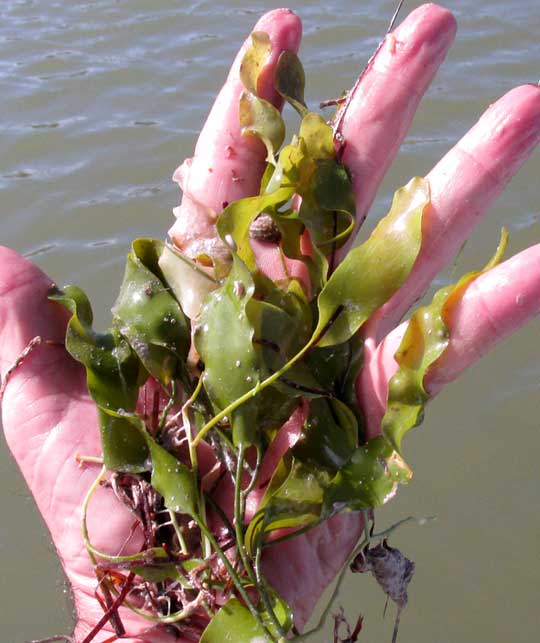Excerpts from Jim Conrad's
Naturalist Newsletter
from the February 8, 2015 Newsletter issued from Río Lagartos, on the Yucatan Peninsula's northern coast (~N21.60°, ~W88.16°), Yucatán state, MÉXICO
CAULERPA ALGA
Another green alga plucked from the estuary bottom during a very low, full-moon tide was the tongue-shaped one shown below:

A shot showing a submerged population with the blades heavily covered with the marly silt that collects on everything in the estuary's waters is shown below:

This looks like CAULERPA PROLIFERA, listed in a study by Morales and Ortegón, that was presented at a symposium in 2013 sponsored by the Universidad Autónoma de Yucatánas. That study found Caulerpa prolifera to be the second-most commonly detected alga off the Yucatan's shores. Occurring in warm, shallow, marine waters, it's spottily distributed pretty much worldwide. Often it's grown in home aquaria because it's handsome and easy to grow. Still, there's no good English name for it, so people just call it Caulerpa prolifera.
Caulerpa prolifera is a much more complex plant than what it looks like. Like other members of the green alga order Bryopsidales, each Caulerpa prolifera plant consists of a single giant cell with multiple nuclei. Some species of the genus Caulerpa are several yards (meters) across, so here we're talking about potentially mind-bogglingly large cells. Having no cell walls to impede movement of organelles within the plants, photosynthesizing chloroplasts migrate from one part of the organism to another, responding to light levels. One thing this means is that the fast growing plant's new parts that develop during the night are white, without green chloroplasts, but with sunlight the parts turn green. If sediment covers part of the blade, chloroplasts migrate to parts receiving more sunlight.
Normally, Caulerpa prolifera reproduces by fragmentation. Pieces of it no larger than a fly can grow into new plants. However, under special conditions, as when waters cool drastically, individuals can reproduce by a process known as "holocarpy." Holocarpy is when the entire contents of the giant cell forming the plant are used up to create sexual cells, or gametes, converting the entire plant to nothing more than an empty husk filled with untold numbers of sexual cells. These gametes, which bear little tails enabling them to swim, escape into the water where they fuse and form zygotes, a zygote being the first cell of a new organism. Caulerpa plants are "monoecious," so each plant produces gametes of both sexual types.
Caulerpa prolifera plays a big part in the estuary's ecology, for it helps keep in place and consolidate the estuary floor, enabling more complex flowering plants -- especially seagrasses -- to get established, and we've seen that seagrasses, like prairie grasses, engender complex and beautiful ecosystems.